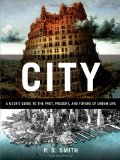Summary | Excerpt | Reviews | Beyond the Book | Readalikes | Genres & Themes | Author Bio

 Book Reviewed by:
Book Reviewed by:
Elizabeth Whitmore Funk
Buy This Book
Later, Montezuma invited his foreign visitors to climb the steps
to the summit of the Templo Mayor, or Great Temple, the highest
and most sacred structure in the city. At the top, the tlatoani (literally
the 'speaker' or ruler) of the Mexica people took Cortés by the
hand and, writes Díaz, 'told him to look at his great city and all the
other cities standing in the water, and the many others on the land
around the lake'. The two men stood with one of the greatest cities
in the world at their feet. For this was not just a meeting between the
peoples of two continents. It was a meeting between two great urban
civilisations.
Despite the linguistic and cultural barriers separating them, the
Spaniards could not fail to be impressed by a people who were able
to build a city as great as Tenochtitlán. The city in the lake was a
triumph of organisation as well as of craftsmanship and engineering.
From their vantage point they saw the causeways leading into the city
and the aqueducts bringing freshwater. They saw a flotilla of canoes
laden with provisions and cargo. In the city itself they noted that all the
houses had flat roofs, many converted into roof gardens, and that most
could only be reached by canoe or across a drawbridge. And among
the private residences they saw temples and shrines rising 'like gleaming
white towers and castles'. It was, said Díaz, 'a marvellous sight'.
What they saw then from the Great Temple, and discovered later
for themselves while exploring on foot, astonished the Spanish soldiers.
Some of them had visited great cities like Constantinople and
Rome, but this was on a different scale. In his dispatches to the king
of Spain, Cortés prefaced his descriptions of the city with the warning
that his reader would find it 'so remarkable as not to be believed,
for we who saw them with our own eyes could not grasp them with
understanding'. The 'great city' had many fine streets and squares,
one of which was arcaded and served as a vast market. This was the
great market of Tlatelolco, once part of a separate island city, now
absorbed into the metropolis. The Spaniards had 'never seen a market
so well laid out, so large, so orderly, and so full of people'. Each day
sixty thousand people came to buy and sell. Here were goods from
every corner of the Aztec empire, goods which Cortés itemised for
his imperial master, who was eager for news of the wealth of his new
lands.
The market was divided into sections like a modern department
store. One part offered live animals: 'chickens, partridges and quails,
wild ducks, fly-catchers, widgeons, turtledoves, pigeons, cane birds,
parrots, eagles and eagle fowls, falcons, sparrow hawks and kestrels …
rabbits and hares, and stags and small gelded dogs which they breed
for eating'. There were brightly coloured fruits and vegetables - from
cherries and plums to onions, leeks, garlic, watercress, borage, maize
and artichokes. In another part of the market fresh flowers filled the
air with a heavy fragrance. Elsewhere cooked food was for sale, such
as chicken and fish pies, tripe, as well as sweet foods, like honey cake
and chocolate. Finely crafted goods were also on offer, including ornaments
made from gold, silver, bone, shell and feathers. In his account,
Díaz mentions seeing the skins of tigers, lions, otters, jackals, deer and
badgers being traded. In the textile market, there was a greater range
of spun cotton in all the colours of the rainbow than in the famous
silk market at Granada, according to Cortés. Beyond the great market
were streets where only herbalists or apothecaries traded, selling and
prescribing herbal medicines.
When Cortés and his men entered Tenochtitlán it was a thriving
city covering about five square miles and, with a population of at least
200,000 people, bigger than any Spanish or, indeed, most European
cities. (In 1551 London's population was about eighty thousand.) At
a time when the streets in European cities were often open sewers,
choked with stinking rubbish, Tenochtitlán's wide streets were kept
spotlessly clean by a workforce of a thousand men. Indeed, the city
provided people with public toilets (reed huts) on all the roads where
they could - as Díaz so delicately phrased it - 'purge their bowels
unseen by passers-by'. The excrement was collected 'for the manufacture
of salt and the curing of skins'. It was also used as fertiliser.
Excerpted from City by Peter D Smith. Copyright © 2012 by Peter D Smith. Excerpted by permission of Bloomsbury. All rights reserved. No part of this excerpt may be reproduced or reprinted without permission in writing from the publisher.





The Flower Sisters
by Michelle Collins Anderson
From the new Fannie Flagg of the Ozarks, a richly-woven story of family, forgiveness, and reinvention.

The House on Biscayne Bay
by Chanel Cleeton
As death stalks a gothic mansion in Miami, the lives of two women intertwine as the past and present collide.

The Funeral Cryer by Wenyan Lu
Debut novelist Wenyan Lu brings us this witty yet profound story about one woman's midlife reawakening in contemporary rural China.
Your guide toexceptional books
BookBrowse seeks out and recommends the best in contemporary fiction and nonfiction—books that not only engage and entertain but also deepen our understanding of ourselves and the world around us.